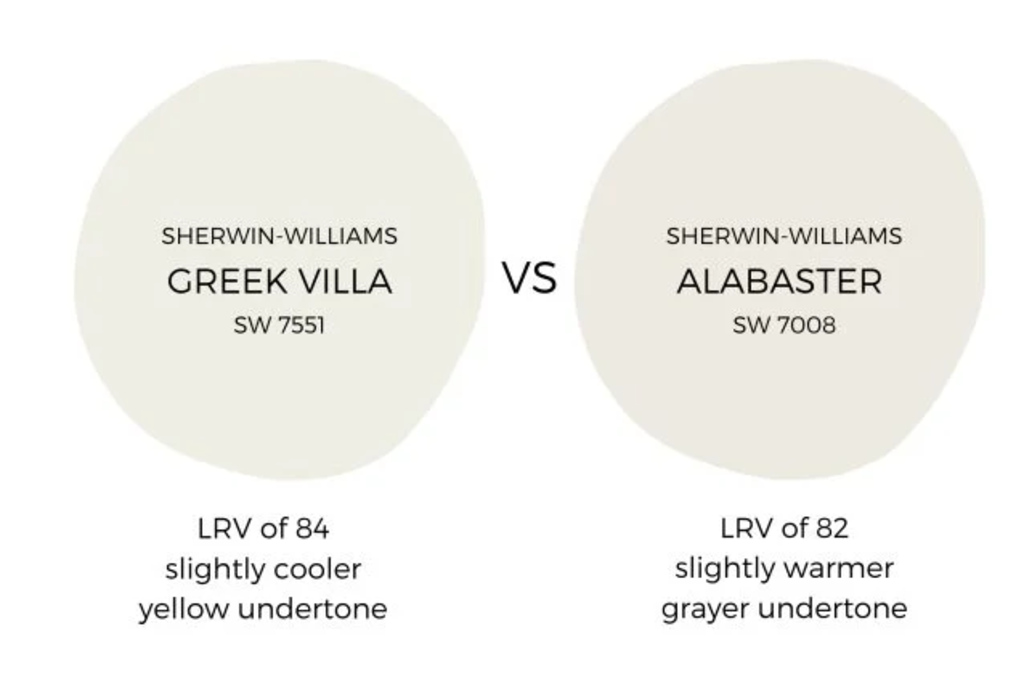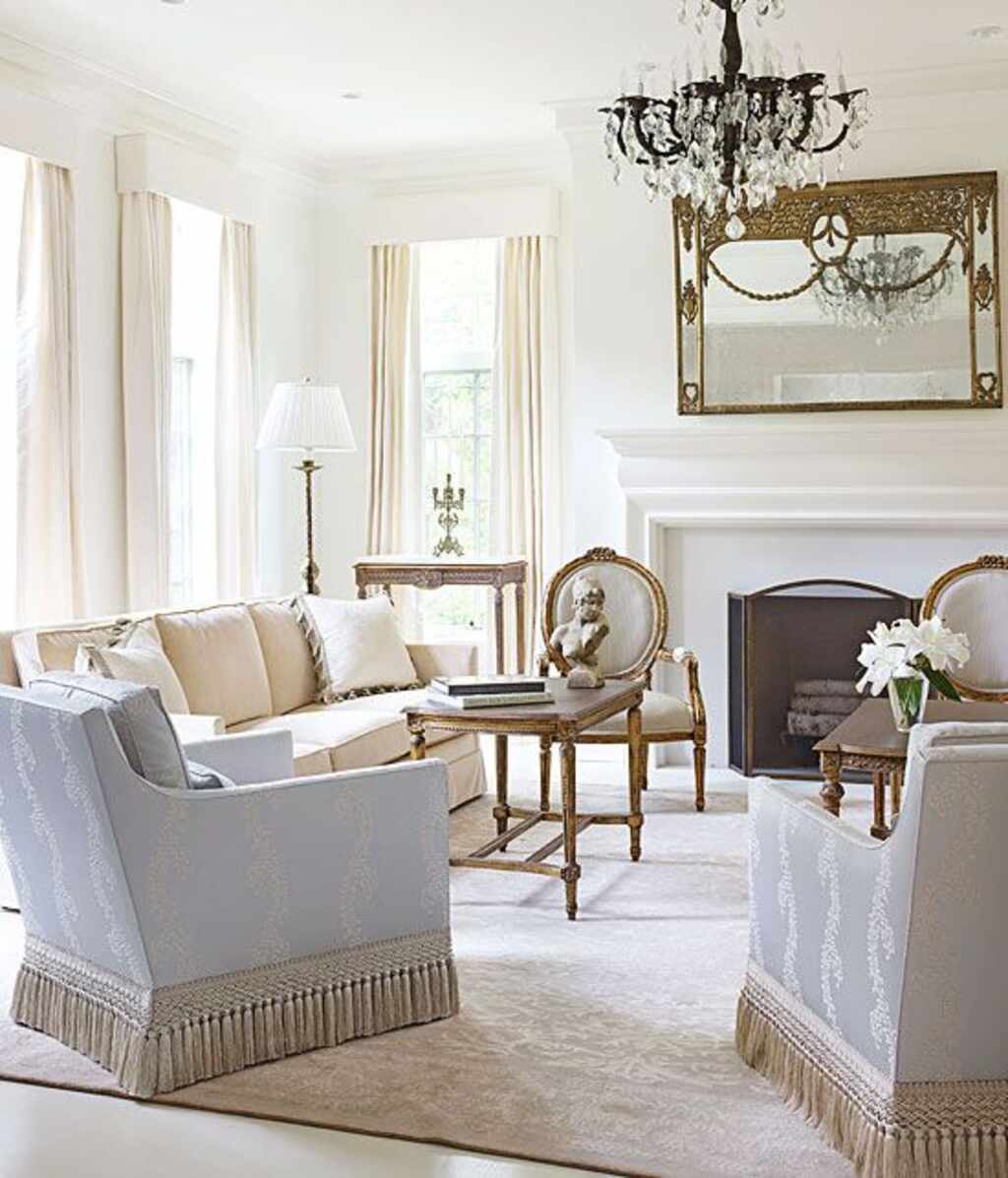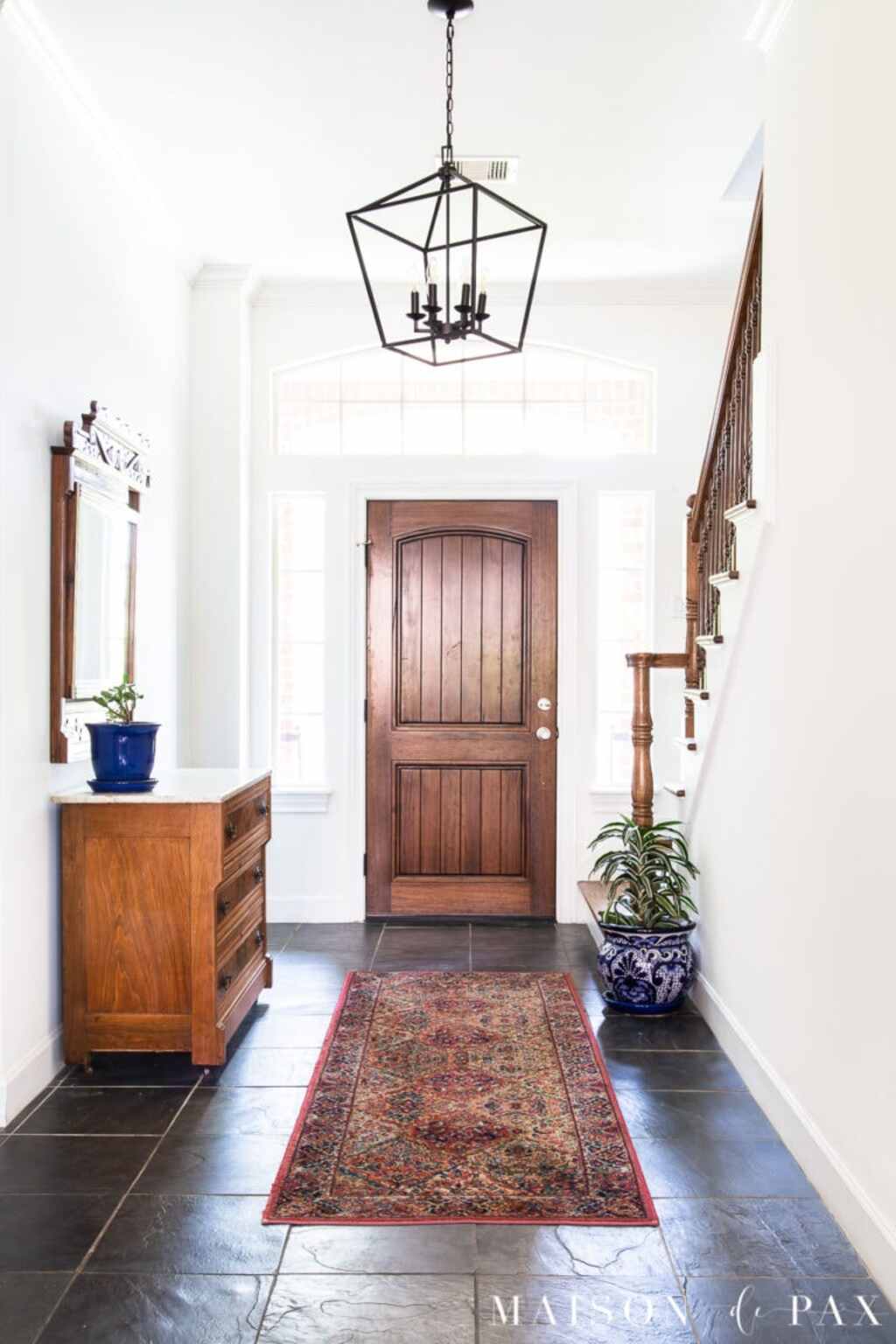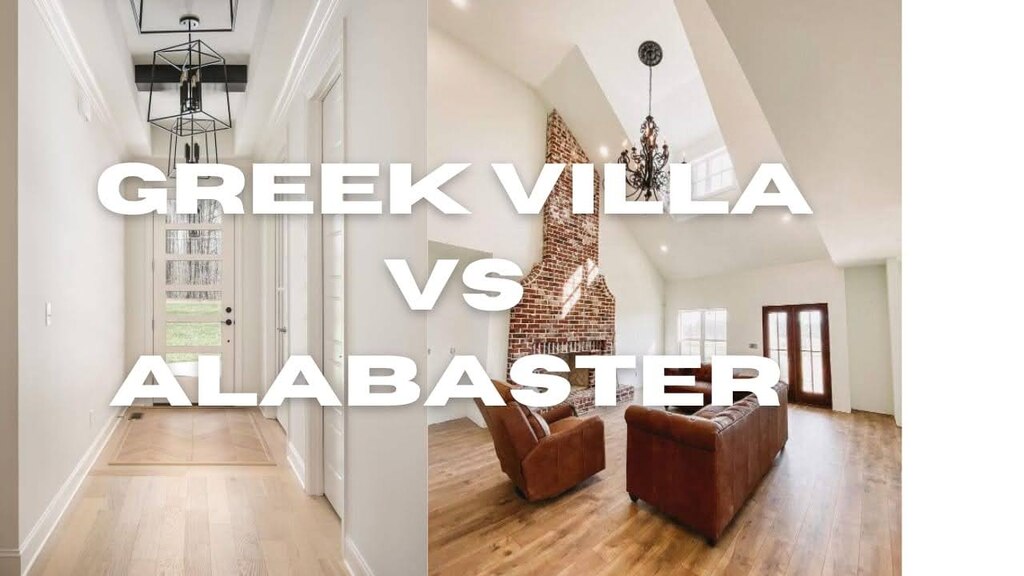This blog is all about two identical whites: Greek Villa vs Alabaster.
Picking the perfect white paint isn’t as easy as it seems. If you’ve ever found yourself torn between Sherwin-Williams Greek Villa and Alabaster, you’re not alone. Both of these stunning whites promise warmth, elegance, and a sense of timelessness.
So, how do you know which one will work best in your space? Is Greek Villa a bit too warm for your taste? Could Alabaster look too stark under certain lighting?
In this post, we’re going to dive into the unique qualities of each color—debunking the mystery behind their undertones and helping you decide which one will bring your vision to life.
Greek Villa (SW 7551)
Greek Villa is a soft, creamy white that brings warmth and a sense of luxury to any space.
Its subtle beige undertones give it a rich, inviting quality that works wonderfully in both traditional and contemporary interiors.
This color has a soothing, elegant vibe, perfect for creating a calm, welcoming atmosphere.
Greek Villa can handle various lighting conditions without losing its warmth, making it a great option for spaces where you want a cozy feel without too much contrast.
Alabaster (SW 7008)
Alabaster is a versatile, warm white with a touch of creaminess that makes it a bit softer than pure white.
Its gentle undertones are slightly cooler compared to Greek Villa, which gives it a fresh, airy feel.
Alabaster is known for its ability to reflect light beautifully, making it a popular choice for rooms that need a little extra brightness.
It’s a great option for creating a clean and serene environment, whether you’re using it in a modern or more classic setting.
It’s soft but not too stark, which makes it ideal for spaces where you want a bright, open look without feeling too clinical.
Comparing Greek Villa and Alabaster
 Here’s a comparison between Sherwin-Williams Greek Villa (SW 7551) and Alabaster (SW 7008) to help you better understand their differences:
Here’s a comparison between Sherwin-Williams Greek Villa (SW 7551) and Alabaster (SW 7008) to help you better understand their differences:
|
Feature |
Greek Villa (SW 7551) |
Alabaster (SW 7008) |
|
Color Family |
Warm White |
Warm White |
|
Undertones |
Beige, creamy |
Light cream, soft gray |
|
Light Reflectance Value (LRV) |
84 |
82 |
|
RGB Value |
R: 245, G: 238, B: 222 |
R: 242, G: 238, B: 224 |
|
Best For |
Cozy spaces, traditional settings, living rooms, kitchens |
Bright, airy rooms, modern and minimalist spaces |
|
Warmth |
Warm, inviting |
Soft, fresh |
|
Finish |
Soft, elegant |
Clean, serene |
Comparing LRVs
The Light Reflectance Value (LRV) is a key factor when choosing paint, as it determines how much light a color reflects.
Greek Villa (LRV: 84) reflects a lot of light, making it a great choice for spaces that need a little help brightening up.
Alabaster (LRV: 82) has a slightly lower LRV, so it reflects light in a more subtle way, which can be perfect for certain settings.
North-Facing Rooms
Rooms facing north tend to have cooler, more limited light throughout the day. With its higher LRV of 84, the Greek Villa is ideal for these spaces. It reflects more light, making the room feel brighter and warmer. The creamy undertones will counteract the cool light, creating a cozy, inviting atmosphere without feeling too dark.
South-Facing Rooms
On the flip side, south-facing rooms receive more direct sunlight, which can sometimes feel overwhelming. Here, Alabaster with its LRV of 82 works beautifully. The slightly lower LRV helps soften the intense light, maintaining a bright but balanced feel. Alabaster keeps things fresh and airy without the harshness of overly bright rooms.
Comparing Undertones
Greek Villa has warm, beige undertones that give it a creamy, inviting feel.
The color is often described as soft and luxurious, making it perfect for creating a cozy, welcoming environment.
The warmth in the Greek Villa pairs beautifully with rich, earthy tones, making it ideal for traditional, rustic, or Mediterranean-inspired spaces.
Alabaster also has warm undertones, but it’s a bit cooler than Greek Villa.
It carries a gentle, soft creaminess that leans toward a more neutral feel. While still warm, its undertones aren’t as pronounced, allowing it to blend seamlessly with both warm and cool color palettes.
Alabaster works well in modern, minimalist spaces where you want a fresh, airy vibe without an overpowering warmth.
Comparing VOC
Both Greek Villa and Alabaster are available in low-VOC formulas, with Alabaster also offering a zero-VOC option.
If VOC levels are a primary concern, Alabaster’s zero-VOC option might be the better choice for an even cleaner, healthier environment.
However, both colors will provide a low-impact, fresh look for your space.
Coordinating Colors
Both Greek Villa and Alabaster can be paired with a variety of soft, neutral shades, with Greek Villa leaning toward warmer, earthy tones and Alabaster offering more versatility with both warm and cool accents.
Coordinating Colors for Greek Villa (SW 7551)
- Accessible Beige (SW 7036)
- Dorian Gray (SW 7017)
- Aesthetic White (SW 7035)
- Mindful Gray (SW 7016)
- Sanderling (SW 7513)
- Bunglehouse Beige (SW 2865)
- Cavern Clay (SW 7701)
- Shiitake (SW 9173)
Coordinating Colors for Alabaster (SW 7008)
- Repose Gray (SW 7015)
- Pure White (SW 7005)
- Sea Salt (SW 6204)
- Extra White (SW 7006)
- Rainwashed (SW 6211)
- Oyster Bay (SW 6206)
- Mindful Gray (SW 7016)
- Ballet White (SW 7561)
Where To Use SW Greek Villa?

I’ve personally used Greek Villa (SW 7551) in a few spaces, and let me tell you, it’s a total game-changer. Its warm, creamy undertones bring an instant sense of comfort and coziness, making it perfect for areas where you want to feel relaxed and at home.
I painted my living room with a Greek Villa, and it made the space feel so welcoming. The warm undertones balanced out the natural light and created a cozy environment, perfect for family gatherings or a quiet evening with a book.
Kitchens are another great place for the Greek Villa. I used it on the walls of my kitchen, paired with light wood tones, and the result was stunning. It gave the space a clean, fresh feel while still maintaining that warmth that makes a kitchen feel inviting.
If you have a bedroom that could use some extra coziness, Greek Villa is a fantastic choice. The soft, warm color promotes relaxation, making it ideal for creating a restful, serene space for winding down after a long day.
Hallways and entryways also benefit from the Greek Villa. It gives off an inviting vibe that makes your home feel more open and welcoming to guests.
Where To Use SW Alabaster?

I’ve had the chance to use Alabaster (SW 7008) in several areas of my home, and let me tell you, it’s become one of my go-to shades.
I decided to paint my bathroom with Alabaster, and it completely transformed the space. The lightness of the color made the small room feel much larger and brighter, while still giving it that cozy, inviting feel.
Plus, it pairs beautifully with almost any hardware or accent—think polished chrome or matte black—it’s super versatile!
For hallways, Alabaster is also a winner. It reflects just enough light to make the space feel more open and welcoming, which is exactly what you want in a passage area. It creates a smooth transition between rooms, making your home feel cohesive and elegant.
I also used Alabaster in a home office, and I love how it promotes focus and calm. It’s the perfect neutral backdrop that doesn’t overwhelm the senses but still creates an inspiring, tranquil environment for work.
Conclusion
In the end, both Greek Villa and Alabaster offer unique qualities that can elevate your home in different ways. Greek Villa’s warm, creamy undertones create a cozy, inviting atmosphere, making it perfect for spaces like living rooms, kitchens, or bedrooms. On the other hand, Alabaster’s soft, airy feel brings a fresh, calm vibe, ideal for smaller spaces like bathrooms or hallways, or even a peaceful home office.
Whether you lean toward the warmth of the Greek Villa or the subtle elegance of Alabaster, both colors offer timeless beauty and versatility. My advice? Don’t be afraid to test them out in your own spaces. You might find that one of these Sherwin-Williams whites is exactly what your home needs to feel warm, inviting, and full of life. Happy painting!
FAQs
What color pairs best with the Greek Villa?
Greek Villa pairs beautifully with warm, earthy tones like Accessible Beige (SW 7036) and Dorian Gray (SW 7017), as well as rich accent colors like Cavern Clay (SW 7701) for a cozy, grounded feel.
Which color is better for creating contrast in a room?
Alabaster is a great choice if you’re looking for a soft contrast. It pairs well with both light and dark accent colors, creating a serene contrast that’s not too harsh. Greek Villa, on the other hand, brings warmth and subtle contrast, which is perfect if you’re going for a cozy, cohesive look.
What color trim goes best with Greek Villa?
White or off-white trim complements the Greek Villa beautifully. Consider colors like Pure White (SW 7005) or even a warmer trim color like Sanderling (SW 7513) for a harmonious, soft contrast.
How do I know if the Greek Villa will look too warm in my space?
If you’re unsure about Greek Villa’s warmth, try testing a sample on your walls. The warm undertones might seem more pronounced in rooms with direct sunlight, so consider how much natural light your space gets before making your decision.
Can I use both Greek Villa and Alabaster in the same space?
Yes, you can! Both colors are from the same warm white family, so they complement each other beautifully. Use Greek Villa in areas where you want a bit more warmth and Alabaster in places where you want a fresher, more open feel.

